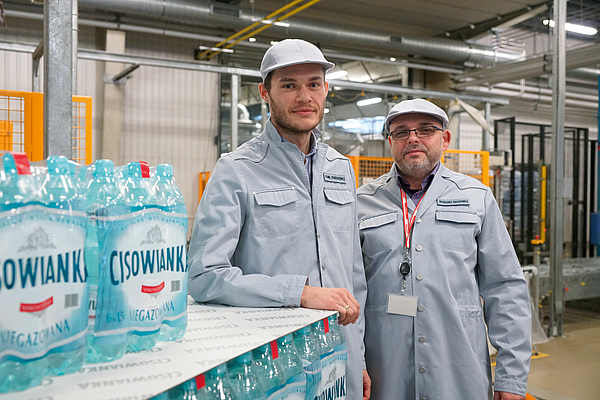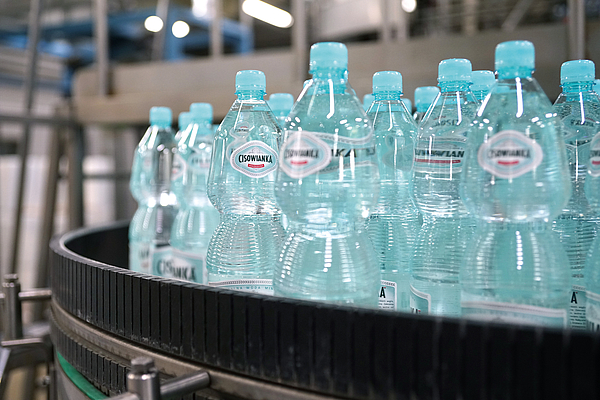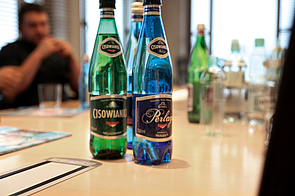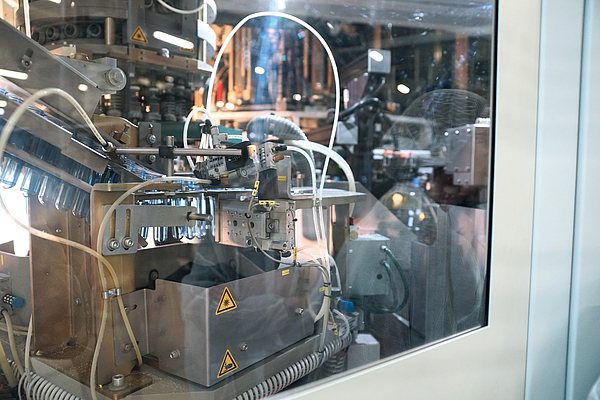
When did Cisowianka install the first PET line?
G. Nachowitz.: The first PET line was installed in ..... and was fitted with an Italian-made filler and a Dynaplast blow moulding machine. That line is still in operation. At the moment we have no free space to install a new rotary system at that particular location.
How many lines are currently running?
K.Banaskiewicz.: We have 8 production lines in total. The main lines are running at 25,000 b/h. Our focus is on flexibility rather than high speed. Some lines for carbonated water run without any changes in bottle format. For instance, our 0.5 l bottle is produced on a Krones combi, where we only change the base as we switch from still to carbonated water. Our bottles are currently produced on Sidel, KHS and Krones lines. In order to increase the output, our plan is to modify each line to a block concept, as we have minimum space at our disposal. Given the growing market in Poland and the rise in production output at Cisowianka, TCO, quality and availability are important factors.
Is the 1.5 l bottle your standard bottle format? Is the share of 500 ml bottles on the rise?
G.N.: We definitely see the shift to smaller packaging formats, but the 1.5 l bottle is still the standard for us.
In selecting a machine supplier, what are the main criteria that you apply?
G.N.: As I said, given the limited shop-floor space at our facility, machine dimensions are a priority. Also the price, obviously. Last but not least, the service must be in line with our requirements. It's a problem when trucks are waiting at the gate because it takes ages to bring a machine back into production.
What are the special requirements for your applications?
K.B.: For instance, our PET bottles have a paper label on the shoulder and body. For suppliers of labelling machines it is a standard practice to use plastic labels on PET and paper labels on glass. Paper labels on PET bottles are a non-standard option, and it is supported by the KHS labeller.
Paper labels on on shoulder and body on PET bottles is definitely not the easiest choice. So why do you prefer this option?
G.N.: You are quite right, paper labels on the shoulder and body are not only more difficult to apply, but also more expensive. However, the look and feel of paper on a PET bottle is much more attractive. In this way, we can successfully combine the high quality of traditional water and modern packaging.

Is line flexibility one of your priorities?
G.N..: Flexibility is obviously very important. Our lines usually run around three shifts for one product format. During changeovers, errors may occur and affect the overall line efficiency. Today, the output per day is at about 3 million bottles. Our aim is to increase that output. As our available space is limited, we need solutions that will allow us produce more bottles per one square meter. Therefore, block concepts are the best option.
For a local brand such as Naleczow, how big is the competition from European or international brands?
K.B.: The Polish and European bottled water markets are very large and highly saturated, with a noticeable upward trend. The competitive landscape features both local players and global corporations.
G.N.: Compared with giants such as Nestle or Coca Cola, Naleczow Zdroj is a rather small local player. For a company such as ours to compete successfully with international corporations is by no means easy, but not impossible. For many years now, CISOWIANKA has been the leading brand of Poland’s mineral water market. It goes to prove that a top quality product combined with attention to every little detail on the production and distribution side as well as a conscious and unique brand image and marketing policy may give a company a major competitive edge even against global corporations.
What is the key to your success? Is it water quality, marketing, cost advantages, or production efficiency?
G.N.: All these factors are our success drivers. We always try to take a holistic view of the CISOWIANKA brand and to take utmost care of our product all the way from water extraction, through bottling, up to distribution and marketing. In a nutshell, the key to our success lies in superior quality in every aspect and in excellent customer care, i.e. paying attention to the customer’s needs.
How big is the mineral water market in Poland (in l) and what role does mineral water play in Poland vis-a?- vis other beverages?
G.N.: In 2016, consumption of mineral water reached 114-118 litres per capita and is on the rise. No results for 2017 have been published yet, but we expect the upward trend to continue. In the non-alcoholic beverages market, consumption of mineral water is growing at the expense of other beverages. This is driven by the t and healthy lifestyle trend, with consumers looking for natural products with no artificial additives.
How will you strengthen your position in Poland?
K.B.: We have been the leader of Poland’s mineral water market for years, and our market position is growing stronger by the year. Our focus is on water only, we are experts in this business, we offer a premium- quality and fully natural product, and we respect our customers – which they recognise and appreciate. We will continue to deliver our successful sales, marketing and brand image strategies in the future.
Have you adopted any strategies or taken any actions to expand your business in Europe?
G.N.: Our export brand Perlage has been sold mainly to European but also to Asian and American restaurants for a couple of years now. From day one of our export sales, the strategy has remained unchanged and has been consistently delivered: namely, our goal is to steadily expand in foreign restaurant markets and to offer premium quality products to our customers abroad. We do not want to focus on restaurants with star ratings only, our targets are those restaurants where the menu is based on natural and top quality products and where chefs and managers are aware of how important it is to serve prime quality water with the dish.
Obviously, the water market is highly competitive, both in Poland and abroad.
What role does the circular economy and sustainability play in Poland and especially for your company? Where do you see the real challenges to becoming “greener” as a company?
G.N.: The environmental footprint of our company is of key importance to us. In the context of circular economy, we should emphasise that an efficient and effective recycling of empty post- consumer bottles is the key. We believe it to be the major problem and challenge right now. This is the area where the government and recycling operators should play the key role.
K.B.: Due to the nature of our products, their sensitivity, and the characteristics of PET bottles, it is not possible to reuse PET bottles for bottling of natural mineral waters. However, post-consumer PET water bottles are increasingly sought after as recycling material.
G.N.: To operate in an environmentally- friendly way, we are honing the design of our packaging and streamlining our production processes, including bottle blowing, so as to minimise the amount of materials used and thus reduce environmental emissions as well as water and energy consumption.
The policy of Naleczow Zdroj is delivered with due regard to the natural environment and the company’s immediate surroundings. We use environmentally-friendly energy sources and we minimise the consumption of both water and energy. Our in-house wastewater treatment plant is also completely “green”. The main challenge lies with the cost of “green” solutions, which is still quite high in Poland.


What is your opinion on lightweighting as a tool for sustainability?
K.B.: We are indeed interested in the lightweighting of our bottles, and sustainability is also in the centre of our attention. However, I would like to emphasise that the convenience of bottle use is more important. We do not want to push lightweighting to the limits, because we want to produce bottles of optimum quality, which also reinforces the impression of the high quality of our water. Some of our bottle formats have undergone some face-lifting with the help of KHS. Today, we use 27 g to make a 1.5 l bottle.
As regards sustainability, our bottles are blown at a very low temperature combined with a higher p2. This improves bottle strength, stability and its overall quality. Thanks to the AGR quality control equipment, we are able to improve the bottle and process stability for a low-temperature bottle production process.


Is making your own preforms the next step for Cisowianka in the future?
G.N.: Never say never. If it makes sense for us, we will not hesitate to produce our own preforms or even caps. But our priority is the ef ciency and pro tability of our company. We would need in-depth knowledge and know-how so as to avoid mistakes that might have a negative bearing on our performance. However, it might be an option if we continue to grow as we have over the past few years.
Thank you very much.

The comPETence center provides your organisation with a dynamic, cost effective way to promote your products and services.

magazine
Find our premium articles, interviews, reports and more
in 3 issues in 2026.


